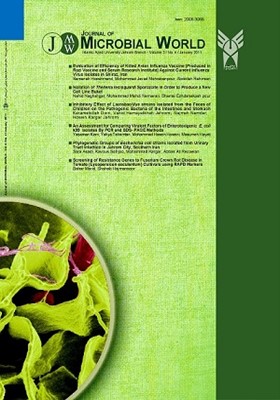Phylogenetic groups of Escherichia coli strains isolated from urinary tract infection in Jahrom city, southern Iran
Subject Areas : Medical MicrobiologySara Asadi 1 * , kavous Solhjoo 2 , Mohammad Kargar 3 , Abbas Ali Rezaeian 4
1 - Department of Microbiology, Jahrom Branch, Islamic Azad University, Jahrom, Iran
2 - Department of Microbiology, Jahrom University of Medical Sciences, Jahrom, Iran
3 - Department of Microbiology, Jahrom Branch, Islamic Azad University, Jahrom, Iran
4 - Department of Microbiology, Jahrom Branch, Islamic Azad University, Jahrom, Iran
Keywords: PCR, E. coli, Phylogenetic groups, Urinary tract infections,
Abstract :
Background and Objective: Escherichia coli is a causative agent of over 80% of urinary tract infections in all ages of the society. Strains of Escherichia coli are divided into four phylogenetic groups. Most of pathogenic extra-intestinal strains often belong to groups D and B2. This study aimed to define the phylogenetic groups of E. coli isolated from urinary tract infections in south of Iran. Material and Methods: This cross– sectional study was carried out on the patients with urinary tract infection who admitted to peymanieh hospital of Jahrom in 2010. Specific biochemical tests were used for identification of bacteria. The phylogenetic groups of E. coli strains were determined by the PCR method and using two specific primers yjaA ChuA and TspE4.C2. Results: Out of 60 identified E. coli, 78.34% were isolated from women while just 21.76% were isolated in men. The most common identified groups were classified as D (70%), A (23.3%) and B1 (6.7%), and none of the species belonged to the B2 group. Data analysis revealed no significant relationship between phylogentic groups with the variables age, sex, history of urinary tract infection, previous history of antibiotic use and hospitalization. Conclusion: The results showed that most of the E. coli strains isolated from urinary tract infections in this region belonged to phylogenetic group D. Also, the results obtained from this region was different from other area.
1. Clermont O, Bonacors S, Bingen E. Rapid and simple determination of Esherichia coli phylogenetic Group. Appl Environ Microbiol, 2000; 66(10): 4555-4558.
2. Duriez P, Clermont O, Bonacorsi S, Bingen E, Chaventré A, Elion J, Picard B, Denamur E. Commensal Escherichia coli isolates are phylogenetically distribution among gegraphically distinct human populatious. J Microbiology, 2001; 147(6):1671-1676.
3. Jonhson JR, Stell AL. Extended Virulence of genotyping of Escherichia coli strains from Patients with urosepsis in relation to phylogeny and host Compromise. J Infect Dis, 2000; 18(1): 261-72
4. Orsi RH, Stoppe NC, Sato MIZ, Prado PI, Ottoboni LMM. Phylogentic group distribution among Escherichia Coli isolated from rivers in saopaul state, Brazil.World J Microbiol Biotechnol. 2008; 24(8): 1573-1577.
5. Foxman B. Epidemiology of urinary tract infections: Incidence, morbidity, and economic costs. Am J Med. 2002; 113(1A) :5-13.
6. Saeed MA, Haque A, Ali A, Mohsin M, Bashir S, Tariq A, Afzal A, Iftikhar T, Sarwar Y. Relationship of drug resistance to phylogenetic groups of E. coli isolates from wound infections . J Infect Dev Ctries 2009; 3(9): 667-670.
7. Kanamaru S, Kurazono H, Nakano M, Terai A, Ogawa O, Yamamoto S. Subtyping of uropathogenic Escherichia coli according to the pathogenicity island encoding uropathogenic-specific protein: comparison with phylogenetic groups. Int J Urol, 2006; 13(6): 754-760.
8. Hancock V, Nielsen EM, Krag L, Engberg J, Klemm P. Comparative analysis of antibiotic resistance and phylogenetic group patterns in human and porcine urinary tract infectious Escherichia coli. APMIS. 2009; 117(11): 786-790.
9. Johnson JR, Owens K, Gajewski A, Kuskowski MA. Bacterial characteristics in relation to clinical source of Escherichia coli isolates from women with acute cystitis or pyelonephritis and uninfected women. J Clin Microbiol. 2005; 43(12):604-672.
10. Ghenghesh KS, Elkateb E, Berbash N, Abdel Nada R, Ahmed SF, Rahouma A, Seif-Enasser N, Elkhabroun MA, Belresh T, Klena JD. Uropathogens from diabetic patients in Libya: virulence factors and phylogenetic groups of Escherichia coli isolates. J Med Microbiol , 2009;58(8):1006-1014.
11. Zhao L, Chen X, Zhu X, Yang W, Dong L, Xu X, Gao S, Liu X. Prevalence of virulence factors and antimicrobial resistance of uropathogenic Escherichia coli in Jiangsu province (China). Urology. 2009: 74(3):702-707.
12. Sawma-Aouad G, Hashwa F, Tokajian S. Antimicrobial resistance in relation to virulence determinants and phylogenetic background among uropathogenic Escherichia coli in Lebanon. J Chemother. 2009; 21(2):153-158.
13. Ho PL, Wong RC, Chow KH, Que TL. Distribution of integron-associated trimethoprim-sulfamethoxazole resistance determinants among Escherichia coli from humans and food-producing animals. Lett Appl Microbiol. 2009; 49(5):627-634.

